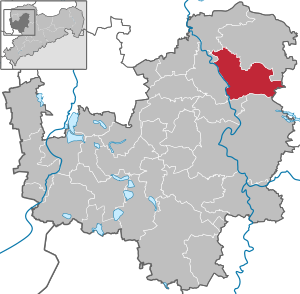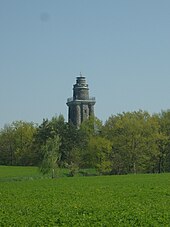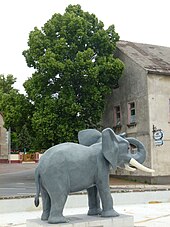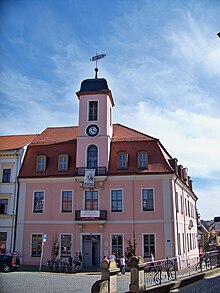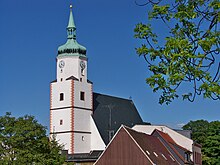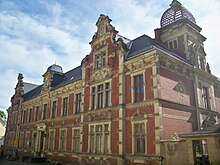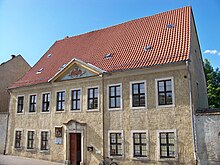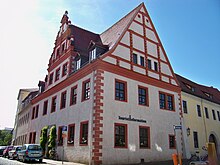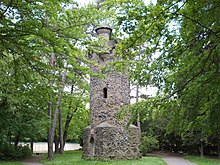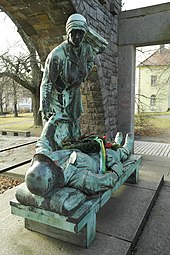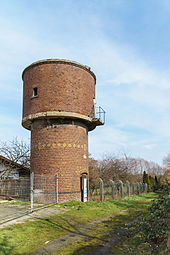Spice up
| coat of arms | Germany map | |
|---|---|---|

|
Coordinates: 51 ° 22 ′ N , 12 ° 44 ′ E |
|
| Basic data | ||
| State : | Saxony | |
| County : | Leipzig | |
| Height : | 124 m above sea level NHN | |
| Area : | 69.03 km 2 | |
| Residents: | 16,209 (Dec. 31, 2019) | |
| Population density : | 235 inhabitants per km 2 | |
| Postal code : | 04808 | |
| Primaries : | 03425, 034261 | |
| License plate : | L , BNA, GHA, GRM, MTL, WUR | |
| Community key : | 14 7 29 410 | |
| LOCODE : | DE WZN | |
| City structure: | 16 districts | |
City administration address : |
Friedrich-Ebert-Strasse 2 04808 Wurzen |
|
| Website : | ||
| Lord Mayor : | Jörg Röglin ( SPD ) | |
| Location of the city of Wurzen in the Leipzig district | ||
Wurzen is a large district town in the northeast of the Leipzig district in Saxony . The city has been the cathedral city for 900 years and thus at the same time the center and namesake of the Wurzener Land . As the birthplace of the poet Joachim Ringelnatz the city leads unofficially nicknamed Ringelnatz city .
geography
Wurzen is located on the eastern high bank of the Mulde , about 30 kilometers east of Leipzig , on the oldest German long - distance railway line Leipzig – Dresden and on federal highway 6 . The B 107 runs west of the city. In the southeast the urban area borders on the Wermsdorfer Forest . The Mühlbach that rises there flows through the urban area. The A 14 south of the city can be reached via the Grimma junction (about 20 kilometers).
Local division
history
On the Wurzener Stadtflur (Crostigall), recent archaeological excavations have demonstrated a settlement continuity of around 6000 years. The region was inhabited by Germanic people until the 6th century. The oldest (?) Settlement cells of today's city are - like the place name - of Slavic origin. Wurzen is mentioned for the first time in 961 in a document from Otto I as Vurcine and Civitas . The castle and the market settlement drew their importance from their location at the junction of the Via Regia over the Mulde river and its intersection with an old salt road from Halle to Prague . Wurzen belonged temporarily to the diocese of Merseburg and after 995 came to the diocese of Meißen . Bishop Herwig founded the Wurzen collegiate monastery in 1114 , which became Protestant in the 16th century and still exists ( cathedral chapter ). A market settlement was established east of the older castle settlement around 1150 by the bishops of Meissen . The expansion of the country , especially through the settlement of farmers from the western territories of the empire (" Kührener settlement contract" 1154 for 15 Flemish farming families) and the establishment of their own secular territorial rule ( Wurzener Land ) made the newly founded market settlement as a central location grow rapidly.
The development of the city reached a high point in the 15th and 16th centuries, when the bishops of Meissen temporarily resided here and undertook significant building activities (castle, cathedral extension, St. Wenceslai church). After the division of the Wettin lands (1485), the patronage over Wurzen and Wurzener Land was jointly exercised by the Ernestines and Albertines . Both lines were ultimately aimed at secularization of the episcopal territory, which u. a. 1542 led to the so-called " Wurzener Feud " ("Fladenkrieg"). Wurzen and the so-called "Wurzener Land", which surrounds the city mainly east of the Mulde, did not belong to the Wettin lands until 1581, but were secular property of the bishops of Meissen, who resided in Wurzen several times, since 1487 more and more often and longer. Even after the "surrender" and "resignation" of the last bishop Johann von Haugwitz in 1581, the area was administered until 1818 by a specially appointed Saxon monastery government. Only then did the Wurzener Land become part of Saxony as an administrative district in the true sense of the word.
In 1581 Wurzen came to Albertine Saxony , which in the meantime, as a result of the Schmalkaldic War, had acquired the electoral dignity in 1547 and which now had Wurzen and the monastery area ( Wurzener Land ) administered by a specially appointed monastery government (until 1818).
In Wurzen 1570-1659 persecutions of witches were carried out: five people were involved in witch trials, one man was whacked with “fruit of the body” on charges of sorcery in 1570, one woman died in custody. The economic and demographic decline of the city, caused by the plague epidemics (especially in 1607), city fires and the consequences of war, took place in the 17th and 18th centuries . During the Thirty Years' War , the town was plundered by the Swedes in 1637 ("Wurtznian Creutz and Torture Week") and almost completely burned down. The Northern War , but especially the Seven Years' War and the Napoleonic Wars , let the city wither away. Only after the downsizing of Saxony after the Congress of Vienna (1815) and the construction of road bridges over the Mulde and Flussaue (1830/1832) did a remarkable upswing set in again.
On July 31, 1838 Wurzen was connected to the German railway network ( Leipzig-Dresden Railway ). The first railway bridge in Germany was built over the Mulde , the bridge over the B 6 is today the oldest German railway bridge in operation. Then it developed rapidly as an industrial city (especially food and textile industry, metal processing). The population quadrupled between 1850 and 1914. This development also continued in the 20th century until the 1970s. After German reunification, there was another strong economic and demographic decline, the number of inhabitants fell to a threatening extent and the average age of the inhabitants rose.
As a result of the stormy industrialization in the second half of the 19th century, the workers' movement developed early in Wurzen . For a time in the 1880s, Julius Künzel was the only social democratic city councilor in Saxony. In 1903 a subdistrict of the SPD was founded in Wurzen . During the November Revolution, one of the first workers and soldiers' councils in what was then Saxony acted in Wurzen . Albert Kuntz worked as a prominent KPD member in Wurzen until 1923 . a. in the city council. In 1926 a coalition of the SPD and KPD succeeded in establishing a majority in the city council and electing Georg Boock for the first time as a social-democratic mayor.
Wurzen, which previously belonged to the administrative authority of Grimma , became a district-free town in 1924 , one of the smallest in Germany, and became part of the Grimma district in 1946 and the Wurzen district in 1952 until its dissolution in 1994.
From 1935 to 1945 the city housed a military district command and during the Second World War several anti-aircraft units. From October 1943 to April 1945, Wurzen experienced several American air raids , with over 40 fatalities. The most severe took place on October 7, 1944, when 13 “Flying Fortresses” B-17 dropped around 85 high-explosive explosive bombs on Wurzen, which were actually intended for the Brüx hydrogenation works in northern Bohemia.
From July 1939 to May 1945 Armin Graebert (1898–1947) was Lord Mayor of the city; On April 24, 1945, together with members of the SPD, KPD and the pastors of the Protestant and Catholic churches, he achieved the surrender of the city to Major Victor G. Conley of the 273rd US Infantry Regiment and thus saved it from destruction.
The town's high school, named after Magnus Gottfried Lichtwer since 1993, moved to a new building in 1996 northeast of the historic town center.
Wurzen has been one of the pilot projects in the Free State of Saxony for urban redevelopment east since 2002 . Due to the demographic and economic development of the last few decades, for the first time in the history of Saxony it is necessary to organize a planned demolition of urban housing and the sensible reuse of the cleared areas.
The construction of a new Mulde bridge began in 2004 and was handed over in 2007.
From September 4th to 6th, 2015, Wurzen hosted the 24th day of the Saxons .
Population development
|
|
Incorporations
| Former parish | date | annotation |
|---|---|---|
| Burkartshain | January 1, 1994 | Merger with Kühren to form Kühren-Burkartshain |
| Dehnitz | July 1, 1950 | |
| Corn grove | before 1880 | Incorporation to Mühlbach |
| Cooling | January 1, 1994 | Merger with Burkartshain to form Kühren-Burkartshain |
| Kühren-Burkartshain | October 1, 2006 | |
| Mühlbach | January 1, 1952 | Incorporation to Burkartshain |
| Nemt | March 1, 1993 | |
| Nischwitz | July 1, 1950 January 1, 1957 January 1, 1993 |
Incorporation to Wurzen Ausgemeerung from Wurzen Incorporation to Thallwitz |
| Nitzschka | 1st February 1974 | Incorporation to Burkartshain |
| Oelschütz | June 1, 1936 | Incorporation to Nitzschka |
| Pyrna | January 1, 1956 | Incorporation to Burkartshain |
| Roitzsch | July 1, 1950 | |
| Saxon village | 1st January 1974 | Incorporation to Burkartshain |
| Scatter | July 1, 1950 | Incorporation after Kühren |
| Trebelshain | July 1, 1950 | Incorporation after Kühren |
| Forests | June 1, 1936 | Incorporation to Sachsendorf |
politics
Since the 1990s, the right-wing radical scene has gained more influence in the city than in other comparable municipalities in Eastern Germany, especially among young people. The President of the State Office for the Protection of the Constitution of the Free State of Saxony, Eckehard Dietrich , classified Wurzen in 1996 as “probably the most important center of neo-Nazis in Germany”. The city has been the scene of repeated physical and armed attacks on migrants, journalists and politically more left-wing politicians. Activists count hundreds of incidents over the past 20 years. Attacks in neighboring cities are also sometimes planned and staffed by the Wurzen scene. Sports facilities that offer combat training are also important.
The network for democratic culture, the Wurzen location initiative, the parishes and the city administration are committed to countering the concentration of right-wing violence in Wurzen, which has been spread through the media, and are therefore themselves exposed to right-wing violence. Nonetheless, it represents a persistent problem for the city. The reluctance of the police and the judiciary to perceive and prosecute right-wing crimes is also lamented.
City council
After the local elections on May 26, 2019 , the city council is composed as follows (changes compared to 2014):
- CDU : 7 seats (−6)
- BfW - Citizens for Wurzen - Independent voters' association: 6 seats (0)
- AfD : 4 seats (+4, 2 of which are unoccupied)
- SPD : 3 seats (−1)
- LEFT : 3 seats (−2)
- NFW - New Forum Wurzen: 3 seats (+3)
The group of voters “Neues Forum für Wurzen” has connections to the neo-Nazi scene.
mayor
In June 2008, Jörg Röglin was elected to succeed Jürgen Schmidt in the second ballot. He was confirmed in office in 2015.
coat of arms
Description : In black, a golden horse jumping to the left , red bridled and with a red saddlecloth, it is carrying a golden rider with a hat and crosier . The person in question is St. Wenceslas
Twin cities
-
 Barsinghausen in Germany / Lower Saxony
Barsinghausen in Germany / Lower Saxony
-
 Warstein in Germany / North Rhine-Westphalia
Warstein in Germany / North Rhine-Westphalia
-
 Tamási in Hungary
Tamási in Hungary
-
 Milicz in Poland
Milicz in Poland
economy
Despite the decline in population and the loss of some important industrial companies (including Wurzener Carpet Factory), Wurzen is an important location with a large number of medium-sized companies, mostly with special products on the world market. Unemployment is currently the lowest in the employment district. An economic focus is the production of pastries and confectionery at a subsidiary of Griesson - de Beukelaer . In addition, a large number of high-performance medium-sized mechanical engineering companies and specialist companies (transport systems, lighting equipment manufacture, felt manufacture) are based in the city.
The hospital is a house of standard care run by the district. With the hospital in Grimma, it belongs to the Muldentalkliniken GmbH.
traffic
Wurzen is on the B 6 , the B 107 runs on the left bank of the Mulde through Bennewitz . The A 14 can be reached via the B 107 in the south (connection point Grimma) approx. 15 km away and in the west via the B 6 (connection point Leipzig-Ost) approx. 18 km away. The S3 line of the S-Bahn Mitteldeutschland connects Wurzen with Leipzig city center, the Regional Express connects the city with the main train stations of Dresden and Leipzig. The city is part of the Central German Transport Association and is connected by the Leipzig regional bus with two PlusBus and other regional bus routes.
Municipal gallery on the market
Regular exhibitions take place in the gallery on the market. In 2013, on the occasion of Joachim Ringelnatz's 130th birthday, an exhibition entitled Die Frauen um Ringelnatz was organized .
tourism
Wurzen is located on the Ecumenical Pilgrimage Route , which was set up in 2003 by the Saxon youth pastor's office. In Wurzener Land, this hiking trail largely follows the old route of the medieval Via Regia . Like no other city in central Germany has Wurzen memories of the medieval Jacob pilgrimage : Jakobsplatz, Jakobgasse and - until the Thirty Years' War keen - Jacob Church, Jakobskirchhof and Jacob Hospital.
In the urban area (Gerhart-Hauptmann-Platz) the Via Regia also crosses a second old transcontinental long-distance route, an old salt road from Halle to Prague . This old road , which runs from north to south, is part of the future transcontinental cultural route Via Salaria ( Lübeck - Trapani / Sicily ). In addition, the Lutherweg leads through the city, the next stops are Schildau in the northeast and Trebsen in the south.
The former Glauchau – Wurzen railway line is used as part of the Mulderadweg as far as Grimma . The paved path is also suitable for inline skiers.
Architectural monuments and places of remembrance
- St. Mary's Cathedral , (first consecrated in 1114). Romanesque to late Gothic (1508). Extensive bronze equipment by Georg Wrba (1932)
- City Church of St. Wenceslai (16th / 17th century)
- Catholic Church of the Sacred Heart of Jesus (consecrated in 1902). Neo-Romansch
- Wurzen Castle (1497, temporarily residence of the Bishops of Meissen until 1581 ). Late Gothic
- Krietschmühle , building of the mill works on Mühlgraben that defines the townscape (1917–1925)
- Lossow'sches Haus (cultural history museum with Ringelnatz exhibition). Late Renaissance / Baroque (1668)
- Birthplace of the fabulous poet Magnus Gottfried Lichtwer on Domplatz (17th century)
- Birthplace of Joachim Ringelnatz (17th / 18th century)
- Market fountain in honor of Joachim Ringelnatz (1983)
- The post office gate and post house portal of the former Saxon post office from 1734 on the Crostigall are decorated with coat of arms
- Electoral Saxon distance column from 1724, which once stood in front of the Wenceslaitor there (reproduced in 1984 with the original base)
- Royal Saxon half mile stone (around 1860) from Nemt am Badergraben in Wurzen and whole mile stone as a replica in Burkartshain (original in the Trebsen mountain camp )
- classicist town hall (after fire in 1803). Today the city library and city gallery
- former (royal) grammar school from 1883 with wall paintings by Max Seliger
- Memorial to the fallen of the First World War in the former old cemetery (bronze sculptures of George Wrba inaugurated on May 11, 1930), the young medic represents Elsa Brändström is
- “Pesthäuschen” - memorial for the victims of the plague in 1607 (17th century) in the former old cemetery
- Memorial in the local cemetery for 60 concentration camp prisoners on a death march from a subcamp of Buchenwald concentration camp, who were murdered by SS men in April 1945
- Grove of honor for the soldiers of the Red Army and Albert Kuntz in the city park (1974)
- Memorial plaques on Wurzener Dauerbackwaren GmbH (An der Mulde 5 A) and Wurzener Nahrungsmittel GmbH (Am Mühlgraben 1) commemorated the communist member of the state parliament and resistance fighter Albert Kuntz , who was murdered in 1945 in the Dora-Mittelbau concentration camp .
- Memorial plaque for the victims of Stalinism in the courtyard (2005)
- Millennium stone in Badergraben (2000)
- former north station of the Muldentalbahn ( 1875 ), later district court until 2015
- " Water tower " of the earlier municipal waterworks (1893)
- (Imperial) post office with telegraph tower (1890/91)
- Bismarck Tower , 19.4 m high observation tower on the Wachtelberg (Dehnitz, 1909)
- Nemt village church ( early Gothic )
- Burkartshain village church (13th - 16th century)
- Kühren village church (12th – 16th centuries) with medieval frescoes
- "Elephant Fountain" in Kühren (20th century)
- Nitzschka village church (16th - 18th century)
- Sachsendorf village church (17th century)
- Reconstructed Bronze Age barrows east and south-east of Sachsendorf
- "Johannas Höh" south of Pyrna - 12 m high listed observation tower from 1911
Personalities
Great personalities
mayor
In Wurzen there is the Bürgermeister-Schmidt-Platz and the Boockweg - as a thank you and in memory of the former city leaders Julius Theodor Schmidt and Georg Boock .
Honorary citizen
The following people are honorary citizens of the city of Wurzen (with the year of honorary citizenship) as recognition and thanks for their achievements :
- 1832: Wolf Friedrich von Jeschke on Biehla - Royal Saxon Colonel
- 1857: E. Julius Kauferstein - archdeacon and local school inspector
- 1864: Eduard Friederici - Cathedral Chapter, Privy Councilor, Knight
- 1869: Carl Ludwig Langbein - lawyer
- 1873: Wilhelm Fischer - Royal Saxon mountain master
- 1879: Franz Maximilian Wielisch - monastery superintendent
- 1884: Richard von Koenneritz on Lossa - Privy Councilor, Count
- 1891: Georg Juel - Royal Councilor of Commerce, co-founder of the Wurzen carpet factory and city councilor, initiator of the city park
- 1895: Otto von Bismarck
- 1899: Carl August Bäßler - reindeer
- 1929: Hermann Ilgen
- 1998: Hans Imhoff
- 2005: Horst Schulze - dean and superintendent i. R.
- 2006: Richard Klinkhardt - graduate engineer
- 2013: Philipp Wende , successful rowing athlete from Wurzen
- 2014: Wolfgang Ebert, local and regional chronicler
- 2018: Dietrich Hoffmann, entrepreneur in Wurzen
Varia
- In his novel The Flood in Saxony, the writer Bernd Wagner chose his hometown as the main setting. The novel was produced in 2019 by MDR Kultur as an audio book with Jörg Schüttauf as the narrator.
- The sociologist and photographer Cordia Schlegelmilch , who lived in Wurzen from 1990 to 1996, conducted around 170 in- depth interviews with citizens of the city about the changes after the fall of the Wall; she also documented the upheaval photographically. The Wurzen study obtained from this material can be considered unique.
See also
literature
- Cordia Schlegelmilch : A city tells of the turning point. 1989 Wurzen / Saxony 1990 . Sax-Verlag, Markkleeberg, Beucha 2019, ISBN 978-3-86729-239-9 .
- City administration Wurzen; Wurzen in transition. An illustrated foray through the city from 1850 to the present , ( Horb am Neckar ) 2011.
- Wolfgang Ebert: Wurzen and the Muldenaue. A guide to the city, its landscape and history , Beucha 2010, ISBN 978-3-86729-076-0 .
- Wolfgang Ebert: Historical-topographical lexicon of the city of Wurzen and the districts of Dehnitz, Roitzsch and Nemt . Published in the series "Terra Wurcinensis - The Wurzener Land in the past and present". 3rd edition, Beucha 2008, ISBN 978-3-930076-55-0 , DNB 991585763 .
- Cordia Schlegelmilch: Wurzen . Erfurt 2006, ISBN 978-3-86680-066-3 , DNB 980196620 .
- NovoPrint Verlags GmbH Fellbach and Wurzen City Administration (ed.): Large district town of Wurzen - information brochure with a multi-colored city map. 80 pages, 4th edition, Fellbach / Wurzen 2005.
- City administration Wurzen (ed.): Wurzen - a good piece of Saxony. History & stories of a 1040 year old city. Wurzen 2001, without ISBN.
- Hans Abicht, Reiner Herrig, Rolf and Rosemarie Kunze, Gerhard Marchewitz (eds.): Wurzen - a thousand-year-old city in Saxony . Wurzen 1990, ISBN 3-9700003-0-0 .
- Wurzen 961-1961. Festschrift for the millennium. Published by the council of the city of Wurzen and the editorial team “Der Rundblick” Wurzen. Format A 5, 256 pages. Wurzen 1961.
- Joseph Richter (retired headmaster): Wurzen in words and pictures - A guide through home (= title on the title page; different title on the cover sheet: guide through Wurzen and surroundings ). With city map and area map. 160 pages (A5), Wurzen 1936.
- Joseph Richter: Chronicle of the city of Wurzen. Published with the support of the Wurzener Geschichts- und Altertumsverein, 40 pages, format <A5, Wurzen 1930.
- Max Mucker : What we created - three years of purposeful socialist development work for manual and mental workers and for the entire population of the city of Wurzen. Published by the board of the social democratic people's association Wurzen, 36 pages, Wurzen 1929.
- Cornelius Gurlitt : Wurzen. In: Descriptive representation of the older architectural and art monuments of the Kingdom of Saxony. 20. Issue: Amtshauptmannschaft Grimma (2nd half) . CC Meinhold, Dresden 1898, p. 270.
- Christian Schöttgen : History of the Electoral Saxon Abbey City of Wurzen . Leipzig 1717 ( full text ).
- An extensive tradition of the city of Wurzen for the period 1488-1969 on imperial, constitutional and community affairs, finances, military and war affairs, health and social affairs, trade, commerce, industry, agriculture, order and security police, statistics, elections, School, church, building administration, fire protection, associations, guilds, traffic, foreign and forced laborers, the city court, the office for resettlers, the communities of Grubnitz and Roitzsch are located in the Saxon State Archives, Leipzig State Archives, stock 20629 Stadt Wurzen.
Web links
- Official homepage of the city of Wurzen
- Wurzen in the Digital Historical Directory of Saxony
- Literature on Wurzen in the Saxon Bibliography
- Lore to the Wurzen station in the holdings of the Reich Railway Directorate in Halle in the Saxony-Anhalt State Archives, Dessau department
Individual evidence
- ↑ Population of the Free State of Saxony by municipalities on December 31, 2019 ( help on this ).
- ↑ Wurzener OBM Röglin joins the SPD . In: Leipziger Volkszeitung . No. 197 , August 24, 2017, p. 5 .
- ↑ The city of Wurzen with its cathedral is in line with cathedral cities such as Meißen , Merseburg , Halle (Saale) , Naumburg (Saale) and Magdeburg .
- ^ City of Wurzen: Interesting facts
- ↑ Manfred Wilde: The sorcery and witch trials in Saxony. Cologne / Weimar / Vienna 2003, pp. 647–649.
- ↑ City Chronicle. In: Website of the Wurzener Geschichts- und Atstadt-Verein e. V. Accessed November 11, 2017 .
- ^ Annette Kaminsky: Places of Remembrance: Memorial signs, memorials and museums on the dictatorship in the Soviet occupation zone and GDR. 2nd edition Ch. Links Verlag, 2007, ISBN 978-3-86153-443-3 . P. 383.
- ↑ http://www.tagdersachsen-2015.de/
- ↑ Michael Rademacher: German administrative history from the unification of the empire in 1871 to the reunification in 1990. wurzen.html. (Online material for the dissertation, Osnabrück 2006).
- ↑ Numbers on citipopulation
- ↑ a b c d State Statistical Office of the Free State of Saxony: Area changes
- ↑ a b c d e f g h i Federal Statistical Office (ed.): Municipalities 1994 and their changes since 01.01.1948 in the new federal states . Metzler-Poeschel, Stuttgart 1995, ISBN 3-8246-0321-7 .
- ↑ a b c The Book of Saxony. Municipal publishing house Saxony, Dresden 1943.
- ↑ a b c d lists of the municipalities incorporated since May 1945 and evidence of the breakdown of the independent manor districts and state forest districts. 1952, publisher: Ministry of the Interior of Saxony.
- ↑ Municipal council election 2019. State Statistical Office of the Free State of Saxony , accessed on June 2, 2019 .
- ↑ Peter Maxwill, Carolin Katschak (Video) report from Wurzen: Violence in Wurzen: "For some a foreigner problem, for others a Nazi problem" . In: Spiegel Online . January 27, 2018 ( spiegel.de [accessed September 23, 2019]).
- ^ Heike Baldauf: Neo-Nazis in the East: hatred of Jews in the children's league . In: Spiegel Online . May 31, 2007 ( spiegel.de [accessed September 23, 2019]).
- ^ Smashed the window of the refugee apartment in Wurzen. Retrieved September 23, 2019 .
- ↑ Henrik Merker: Attack on refugees in Wurzen: "We cannot stay here" . In: The daily newspaper: taz . January 15, 2018, ISSN 0931-9085 ( taz.de [accessed on September 23, 2019]).
- ↑ Wurzen: Neo-Nazis attack journalists with weapons. In: Belltower.News. Retrieved September 23, 2019 .
- ↑ "We'll get you, you fat pig!" - kreuzer online. Retrieved September 23, 2019 .
- ↑ Wurzen in Saxony - "A quiet city, but with not good people" . In: Deutschlandfunk . ( deutschlandfunk.de [accessed on September 23, 2019]).
- ^ Wurzen: Chronicle of a right stronghold | de.indymedia.org. Retrieved September 23, 2019 .
- ^ Henrik Merker: Neo-Nazi violence and belittlement in Wurzen. January 23, 2018, accessed September 23, 2019 .
- ↑ Jennifer Stange: Halle for fighting evening: University of Leipzig falls for right-wing extremist freefighters . In: Spiegel Online . March 18, 2015 ( spiegel.de [accessed September 23, 2019]).
- ↑ http://www.ndk-wurzen.de/ ndk.de
- ↑ http://www.standortinitiative-wurzen.de/ standortinitiative-wurzen.de
- ^ Telepolis: right-wing extremism on the football field.
- ^ Oppressive things from Wurzen. ( Memento from May 24, 2008 in the Internet Archive )
- ^ Thugs, agitators and ideologues in Saxony: Cultural Revolution from the Right? Retrieved October 22, 2019 .
- ^ Sarah Ulrich: Right scene in Wurzen near Leipzig: Right of the Mulde . In: The daily newspaper: taz . August 26, 2019, ISSN 0931-9085 ( taz.de [accessed on September 23, 2019]).
- ↑ Incidents in Wurzen reveal: “The city has an image problem”. Retrieved September 23, 2019 .
- ^ Henrik Merker: Neo-Nazi violence and belittlement in Wurzen. January 23, 2018, accessed on September 23, 2019 (German).
- ↑ Henrik Merker: Neo-Nazis are powerful in the provinces. August 28, 2019, accessed September 23, 2019 .
- ^ Sarah Ulrich: Right scene in Wurzen near Leipzig: Right of the Mulde . In: The daily newspaper: taz . August 26, 2019, ISSN 0931-9085 ( taz.de [accessed on September 23, 2019]).
- ^ Police Saxony - Police Directorate Leipzig - Assembly events on January 20, 2018. Accessed on September 23, 2019 .
- ^ Sarah Ulrich: Right scene in Wurzen near Leipzig: Right of the Mulde . In: The daily newspaper: taz . August 26, 2019, ISSN 0931-9085 ( taz.de [accessed on September 23, 2019]).
- ↑ Peter Maxwill, Carolin Katschak (Video) report from Wurzen: Violence in Wurzen: "For some a foreigner problem, for others a Nazi problem" . In: Spiegel Online . January 27, 2018 ( spiegel.de [accessed September 23, 2019]).
- ^ Kai-Uwe Brandt: AfD and New Forum in the Wurzen City Council. Leipziger Volkszeitung , accessed on June 2, 2019 .
- ↑ https://www.statistik.sachsen.de/wpr_alt/pkg_w04_bmlr.prc_erg_bm?p_bz_bzid=BM081&p_ebene=GE&p_ort=14729410
- ^ City arms of Wurzen
- ↑ Kai-Uwe Brandt: Wurzen forges an alliance with Milicz - Lord Mayor Röglin and District Administrator Lech sign partnership document. In: Leipziger Volkszeitung , Muldental edition, September 17, 2014, p. 34
- ↑ Wurzen felt factory
- ↑ Kai-Uwe Brandt: There is music in it: Filzfabrik Wurzen sets the tone worldwide again , Leipziger Volkszeitung , Muldentalkreis edition, August 4, 2016, page 26, almost full-page newspaper article
- ^ Gallery on the market
- ^ Stadt Wurzen (ed.): The women around Ringelnatz , revised new edition 2013, ISBN 978-3-95488-702-6
- ↑ History and current affairs on St. Wenceslai on the Domkantorei-Wurzen website
- ^ LVZ of April 28, 2010
- ↑ Kai-Uwe Brandt: “The Angel of Siberia” - Wurzen wants to pay tribute to Elsa Brändström - memorial of the famous nurse Subject in the culture committee / consul: “A huge treasure for Wurzen”. In: Leipziger Volkszeitung, Muldental edition, May 30, 2015, page 29
- ↑ Bismarck Tower Wurzen on bismarcktuerme.de
- ↑ "Johannas Höh" observation tower Pyrna on navigator-leipzig-mittelachsen.de
- ↑ Archive link ( Memento from October 6, 2014 in the web archive archive.today ).
- ↑ Archive link ( Memento from December 5, 2014 in the Internet Archive ).
- ↑ p. 27 in: Wurzen information brochure , Fellbach 2010, online as a pdf at: http://www.staedte-verlag.de/blaetterbroschueren/ib-wurzen.pdf
- ↑ a b c d https://www.wurzen.de/stadt-wurzen/stadtportrait/persoenitäten/
- ↑ Laudation on honorary citizenship for Wolfgang Ebert ( Memento from July 1, 2015 in the Internet Archive )
- ↑ Kai-Uwe Brandt: Wurzen gives Dietrich Hoffmann honorary citizenship. Leipziger Volkszeitung , online portal. Accessed on November 26, 2018 : “Dietrich Hoffmann is the 17th honorary citizen of the city of Wurzen. Mayor Jörg Röglin (SPD) honored the old entrepreneur for his life's work on Friday evening in the plenary hall of the town hall. "
- ^ Verlag Schöffling & Co., Frankfurt am Main 2018, ISBN 978-3-89561-142-1
- ↑ Haig Latchinian : Bernd Wagner with Wurzen-Roman as a guest at the Leipzig Book Fair. In: Leipziger Volkszeitung , online portal. Retrieved May 15, 2018 .
- ↑ Jörg Schüttauf reads "The Flood in Saxony" by Bernd Wagner. In: Website MDR Kultur. Retrieved May 15, 2019 .
- ↑ Cordia Schlegelmilch : A city tells of the turning point. 1989 Wurzen / Saxony 1990.
- ↑ DNB entry
- ↑ 20629 City of Wurzen. In: State Archives Leipzig. Retrieved March 27, 2020 . (Info text under "Introduction")

